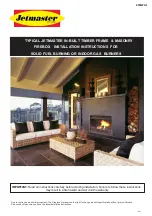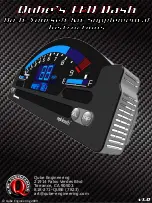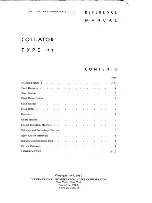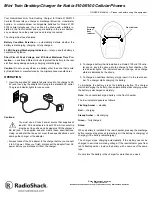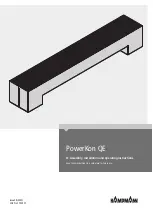
Sensor KNX TH-UP Touch
2
Sensor KNX TH-UP Touch
• Version: 19.07.2017 • Technical changes and errors excepted. • Elsner Elektronik GmbH • Sohlengrund 16 • 75395 Ostelsheim • Germany • www.elsner-elektronik.de •
Technical Service: +49 (0) 7033 / 30945-250
When selecting an installation location, please ensure that the measurement results
are affected as little as possible by external influences. Possible sources of interfe-
rence include:
•
Direct sunlight
•
Drafts from windows and doors
•
Draft from ducts which lead from other rooms or from the outside to the
junction box in which the sensor is mounted
•
Warming or cooling of the building structure on which the sensor is mounted,
e.g. due to sunlight, heating or cold water pipes
•
Connection lines and ducts which lead from warmer or colder areas to the
sensor
Measurement variations from permanent sources of interference can be corrected
in the ETS in order to ensure the specified accuracy of the sensor (offset).
2.3. Composition
2.3.1. Housing
2.4. Assembly of the sensor
First of all fit the windproof socket with connection. Also seal inlet pipes to avoid in-
filtration.
Screw the base plate onto the socket and position the frame of the switching pro-
gramme. Connect the bus line +/- to the black-red plug.
Pin the housing with the notches on to the metal frame, so that device and frame are
fixed.
2.5. Notes on mounting and commissioning
Never expose the device to water (e.g. rain) or dust. This can damage the electro-
nics. You must not exceed a relative humidity of 95%. Avoid condensation.
After the bus voltage has been applied, the device will enter an initialisation phase
lasting a few seconds. During this phase no information can be received or sent via
the bus.
3.
Display and operation at the device
Specifications for the display are set in the ETS and the use of the push buttons is
permitted or disabled.
Basically the display can show a two-row or three-row text (e. g. for measured valu-
es) or a tempertuare controller. You can switch between the two types by pressing
one of the buttons, if this has not been disabled in the ETS.
3.1. Mode display and manual temperature controller
Depending on the ETS setting selected, the mode display will only display show the
current target value, or the base target value setting with scale display. The manual-
ly adjustable range can be set in the ETS.
The following display options are available:
Symbols
Priority (points)
One point: Priority 1/priority control. It is not possible to adjust the temperature au-
tomation system manually. Neither the target temperature nor the operating modes
can be changed using the buttons on the unit.
Two points: Priority 2. The target temperature and operating mode can be changed
using the buttons.
3.2. Change ambient temperature with the buttons
If the mode display is active, the target ambient temperature and the operating
mode can be changed manually using the buttons. The button functions can be blo-
cked in the ETS or be suppressed for Priority 1 operating modes. The individual ope-
rating modes can also be locked for manual selection in the ETS.
1
2
6
3
4
5
Fig. 2
1 Base plate
2 Openings for air circulation
3 Touch sensitive buttons
4 Catches
5 Programming LED (recessed)
6 Programming button (recessed) for teaching device
7
Fig. 3
Mode display with current target value and/or
base target value
Fig. 4
Mode display with scale display for adjusting
the base target value.
The control position in the image reads "Base
target value reduced".
Fig. 5
Mode display with scale display and number.
Shows the set target value change.
The control position in the image reads "Base
target value reduced to 1.0°".
Comfort mode.
Comfort (present) target
temperature will be used.
Standby mode.
Standby (absent during
day) target temperature
will be used.
Eco mode.
Night target temperature
will be used.
Building protection mode.
Building protection target
temperature will be used.
The symbol will blink when
the mode has been activa-
ted but the activation delay
has not yet expired.
Heating mode.
Heating will be provided.
Cooling mode
Cooling will be provided.
Decrease tar-
get tempera-
ture (-)
briefly press
left button
Ambient temperature in the
current mode is decreased.
The sep-size is defined in the
ETS (0.1°C to 5°C).
Increase tar-
get tempera-
ture (+)
briefly press
right button
Ambient temperature in the
current mode is increased.
The sep-size is defined in the
ETS (0.1°C to 5°C).
Change mode
press
left or right button
longer than 2 secs.
Changes between the opera-
ting modes Comfort, Standby,
Eco and Building Protection (if
deblocked in the ETS).
Extend Com-
fort mode
in Eco mode:
press both buttons
at the same time
longer than 2 secs.
Switches from Eco to Comfort
mode again for a certain time
(e. g. if the rooms are used lon-
ger in the evening).
The period is defined in the
ETS (up to 10 hours). The time
remaining in Comfort mode is
displayed.
Fig. 6
Mode display with scale display and range.
Shows the possible adjustment range (as set in
the ETS).
The control position in the image reads "Base
target value reduced".
Fig. 7
Mode display with scale display, range and
number.
Displays the possible adjustment range (as set
in the ETS) and the set target value change.
The control position in the image reads "Base
target value reduced to 1.0°".
Fig. 8
In "HVAC mode with 2x 8 bits" control mode,
points are shown under the symbol, to indicate
the running priority of the current mode.



